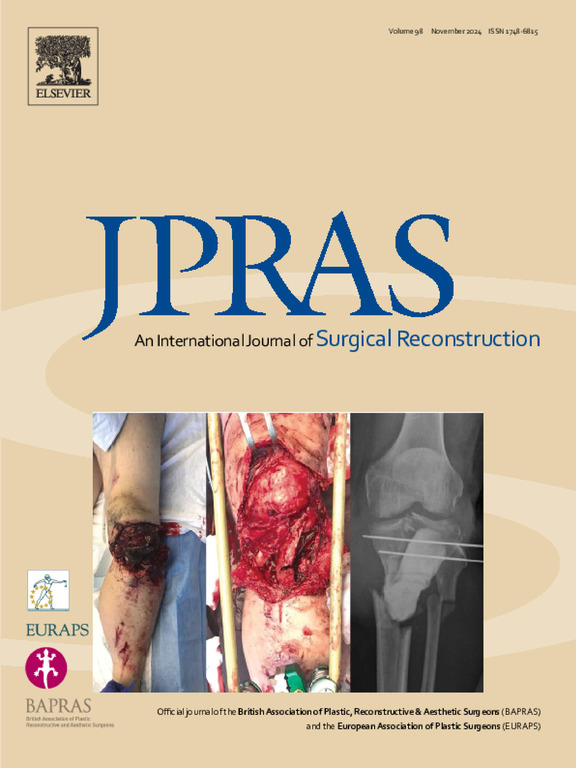Comparative outcomes of allograft with vascularized fibula graft vs vascularized fibula graft alone for post-oncologic lower extremity salvage – Systematic review and meta-analysis
IF 2.4
3区 医学
Q2 SURGERY
Journal of Plastic Reconstructive and Aesthetic Surgery
Pub Date : 2025-07-03
DOI:10.1016/j.bjps.2025.06.026
引用次数: 0
Abstract
Background
Vascularized fibular grafts (VFGs) can be combined with an allograft (Capanna technique) or used alone. Our study aims to compare the outcomes of these two widely used techniques in lower limb salvage.
Methods
PUBMED, EMBASE, Scopus and Web of Science databases were queried, and relevant articles were selected following PRISMA guidelines. Only cohort studies and case series in English and with complete data were included.
Results
Thirty-three studies comprising 560 patients were included. In pediatrics, Capanna and VFG had similar rates: fibula fracture (32.1% vs. 41.0%, p = 0.33), non-union (26.0% vs. 22.7%, p = 0.83), infection (16.8% vs. 11.5%, p = 0.85), reoperation (42.2% vs. 42.9%, p = 1.00), and overall complications (53.3% vs. 48.9%, p = 0.70). Union and weight bearing times were 9.4/11.6 months (Capanna) vs. 8.5/14.1 months (VFG). In adults, Capanna had fewer fibula fractures (17.2% vs. 35.0%, p = 0.03) but more reoperations (49.6% vs. 26.5%, p = 0.005); non-union (14.8% vs. 20.6%, p = 0.35), infection (8.5% vs. 19.5%, p = 0.15), and overall complications (53.4% vs. 40.9%, p = 0.15) were not significantly different. Across all groups, adjuvant chemotherapy was associated with significantly increased odds of non-union (OR: 10.1, 95% CI: 3.3–30.6; p < 0.0001).
Conclusion
The Capanna technique and VFG alone offer comparable overall complication rates and functional outcomes in both pediatric and adult patients. However, the Capanna construct is associated with higher reoperation rates in adults, despite a lower incidence of fibula fractures. Adjuvant chemotherapy significantly increases the risk of non-union and should be carefully considered during surgical planning.
异体移植联合带血管腓骨与单独带血管腓骨用于肿瘤后下肢修复的比较结果——系统回顾和荟萃分析
带血管腓骨移植物(VFGs)可以与异体移植物(Capanna技术)联合使用,也可以单独使用。我们的研究旨在比较这两种广泛使用的技术在下肢抢救中的效果。方法查询spubmed、EMBASE、Scopus和Web of Science数据库,按照PRISMA指南筛选相关文章。仅纳入了英语队列研究和数据完整的病例系列。结果纳入33项研究,560例患者。在儿科,Capanna和VFG的发生率相似:腓骨骨折(32.1%比41.0%,p = 0.33)、骨不连(26.0%比22.7%,p = 0.83)、感染(16.8%比11.5%,p = 0.85)、再手术(42.2%比42.9%,p = 1.00)和总并发症(53.3%比48.9%,p = 0.70)。结扎和负重时间分别为9.4/11.6个月(Capanna)和8.5/14.1个月(VFG)。成人中,Capanna腓骨骨折发生率较低(17.2%比35.0%,p = 0.03),但再手术发生率较高(49.6%比26.5%,p = 0.005);不愈合(14.8%比20.6%,p = 0.35)、感染(8.5%比19.5%,p = 0.15)和总并发症(53.4%比40.9%,p = 0.15)差异无统计学意义。在所有组中,辅助化疗与骨不连的几率显著增加相关(OR: 10.1, 95% CI: 3.3-30.6;p & lt;0.0001)。结论在儿童和成人患者中,Capanna技术和VFG单独治疗的总并发症发生率和功能结局相当。然而,在成人中,尽管腓骨骨折的发生率较低,但Capanna结构与较高的再手术率相关。辅助化疗显著增加骨不连的风险,在手术计划时应慎重考虑。
本文章由计算机程序翻译,如有差异,请以英文原文为准。
求助全文
约1分钟内获得全文
求助全文
来源期刊
CiteScore
3.10
自引率
11.10%
发文量
578
审稿时长
3.5 months
期刊介绍:
JPRAS An International Journal of Surgical Reconstruction is one of the world''s leading international journals, covering all the reconstructive and aesthetic aspects of plastic surgery.
The journal presents the latest surgical procedures with audit and outcome studies of new and established techniques in plastic surgery including: cleft lip and palate and other heads and neck surgery, hand surgery, lower limb trauma, burns, skin cancer, breast surgery and aesthetic surgery.

 求助内容:
求助内容: 应助结果提醒方式:
应助结果提醒方式:


